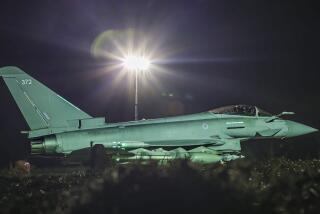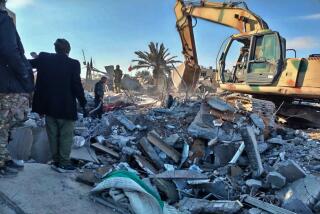The long-awaited battle to free Mosul from Islamic State begins, but a humanitarian crisis looms

Humanitarian groups expect that in the next two weeks, 200,000 will flee the offensive in Mosul. The Dibaga, was built to house 20,000 families and is home to twice as many.
The long-awaited offensive to recapture Mosul from Islamic State began early Monday, launching a major effort by the Iraqi government to oust the extremists from their last major stronghold in Iraq.
“These forces that are liberating you today, they have one goal in Mosul which is to get rid of Daesh and to secure your dignity,” Iraqi Prime Minister Haider Abadi said on state television, referring to Islamic State by its Arabic acronym.
Islamic State seized Mosul, once the country’s second-largest city with a diverse population of about 1.2 million, in 2014.
The battle for Mosul, which had been expected sometime this month, comes as Iraqi forces have been gaining momentum in routing Islamic State, shrinking its territory by a quarter of what it was last year.
This is expected to be the Iraqi military’s most complex operation yet: urban warfare in a densely populated city still full of civilians. But there’s also the promise of scoring an enormous strategic, economic and symbolic victory in the same city where the military was soundly defeated just two years ago.
The extremists have dug ditches around the city and filled them with oil and rubber tires that they have set on fire, filling the skies with black smoke and preventing drones from observing them. They have also developed underground supply lines to avoid being seen, according to Col. John Dorrian, a top spokesman for U.S. forces in Iraq.
The Mosul offensive will be led by 35,000 Iraqi security forces, trained with help from coalition advisors. More than 5,200 U.S. forces are in Iraq, Dorrian said, among 8,000 coalition troops.
The U.S. believes it can limit collateral damage because it spent months using spy satellites and drones to determine where civilians live and work. It has also pinpointed where militants are holed up through the imagery and by collecting cellphone and digital communications.
Officials dropped leaflets on Mosul in recent weeks urging residents to shelter in place once the offensive started. But humanitarian groups expect that in the next two weeks, 200,000 will flee. That will create challenges for security forces attempting to secure the city, screen civilians and direct them to safe exit routes.
By the time the offensive is over, they predict up to a million could be displaced, many with nowhere to go.
The area is already full of those displaced from Mosul and surrounding villages: one camp, Dibaga, was built to house 20,000 families and is home to twice as many, including 400 people sleeping in the mosque and school.
Despite emergency appeals, the United Nations failed to receive additional funding in time to prepare all of the needed emergency camps for those fleeing, and was scrambling to assemble supplies, officials said.
At Dibaga camp, some had high hopes for the offensive.
“Our return depends on liberating the area around us,” said Abdul Khadr Ahmed Mohamed, 23, displaced from a village south of Mosul with his dozen siblings two years ago. Among those sleeping in the camp mosque overnight was a police detective, Abdul Haider, who asked that his last name not be used since his family of six is still in a village south of Mosul dominated by Islamic State.
He fled in June, lost his documents, was detained for screening until Oct. 1 and has lived at the camp ever since. Islamic State forbids residents from using cellphones, whipping them as punishment, but his wife has been sneaking up to the roof of their house at night to call him, asking when the offensive will start.
She told him that Islamic State killed his brother as well as the guide who helped him escape. Relatives also heard Islamic State in their area is preparing 20 suicide bombers.
Why thousands of Iraqi fighters have poured into Syria to aid Assad »
Mosul residents have described in furtive phone calls to relatives the harsh rule of Islamic State fighters. They whipped those who smoked, missed prayers or otherwise violated their moral codes, while opponents were executed, some publicly.
Abdul Haider, 44, plans to return to his village in the next two days to ensure his family is safe. “I’m so afraid for them,” he said of his family — and he’s not alone. “Everyone is calling their families,” he said. “They see the convoys leaving.”
He sees this as the last, painful home stretch for a city that has lived in fear since its hospitals, schools and government were seized. “People in Mosul, what they have been through already is really hard,” Abdul Haider said. “There is just a little bit more.”
It makes sense to shelter in place, he said. That lowered the death toll in other offensives against Islamic State in smaller Iraqi cities. Plus, he said, as he went to find his sleeping mat in the mosque facing a field crowded with scores of blue and white refugee tents, “there is nowhere to go.”
Mosul residents have told aid workers stories of resistance in recent days. Some have raised the Iraqi flag. Others scrawled the Arabic letter M on walls for moqawama, or resistance.
Abdul Haider said his family told him high ranking Islamic State fighters do not plan to stay and defend the Mosul area.
“They are saying the Islamic State leaders’ families are fleeing into Syria,” he said.
Abdul Haider said authorities will have to both protect against sectarian attacks and screen to prevent Islamic State fighters from shaving their beards and blending in among fleeing civilians. They caught two Islamic State fighters trying to get into the camp where he lives during the last month, he said.
The U.S. role will largely be limited to delivering airstrikes in support of advancing Iraqi ground forces, providing intelligence and advising Iraqi and Kurdish commanders to develop strategy. Coalition warplanes have been dropping precision-guided bombs on militant positions, weapons depots and armored vehicles in and around Mosul for more than two years in anticipation of the long-awaited ground invasion to take it back.
Iraqi military forces will be aided by Kurdish fighters, or peshmerga, Dorrian said, and Sunni tribal forces. Shiite militias, a politically powerful force in Iraq, may also play a role in the offensive, but likely outside the largely Sunni city, officials said.
With so many factions and forces involved, there are concerns that sectarian tensions could hinder the offensive, said Patrick Martin, a research analyst who focuses on Iraq at the Institute for the Study of War, a Washington-based think tank.
“There’s so many different political forces that have armed groups converging on the city,” he said. “The mind-set people have is recapturing the city needs to happen. There needs to be an equal amount of attention paid to what the post-capture state of the city looks like to ensure it doesn’t fall back into a vacuum.”
Sunni tribal militias have already been recruiting child fighters from camps for the displaced, Martin noted. Shiite militias entered other mainly Sunni cities after agreeing to remain on the periphery, and clashed with residents.
Some Mosul residents, alienated from the federal government, initially welcomed Islamic State, and if the offensive is not handled well, they could turn back to extremists, Martin said. “If their families are subjected to sectarian violence or they’re treated very poorly in [displaced persons] camps and not allowed to return to their homes, they become disaffected,” he said.
That’s what happened in other areas of the country, he said, like Diyala, where sectarian violence “allowed ISIS to reemerge just a couple of months after they were nominally cleared from the province.”
But Dorrian, the spokesman for U.S. forces in Iraq, wasn’t worried about sectarian tensions getting in the way of the assault on Islamic State, and said that Iraqi forces have been trained to deal with “forces that could get out of hand.”
“We don’t really see that happening. Everybody seems quite focused on getting rid of Daesh,” Dorrian said. “And once they’re out of Mosul, they’re not going to be gone. They’re still going to be around,” he said.
Iraqi troops are still fighting to rid other parts of the country of Daesh, such as the Euphrates Valley area, but Dorrian said they “have demonstrated they can conduct simultaneous operations. They can do that in the Euphrates Valley and do this in Mosul. It puts a tremendous strain on Daesh.”
But Dorrian said Iraqi counter-terrorism forces as well as those trained by coalition advisors will be prepared. “We’ve offered a lot of training for breach operations, urban warfare, improvised explosive device removal, a lot of things that would be useful for the liberation of Mosul,” he said. An “assault force” will be followed by a “hold force” and a “wide area security force” and that includes police and tribal fighters, he said.
“Those will be used to make sure Daesh can’t come back and re-infiltrate areas,” Dorrian said.
Hennessy-Fiske reported from Irbil, Iraq, and Hennigan from Washington. The Associated Press contributed to this report.
molly.hennessy-fiske@latimes.com
ALSO
The battle in Iraq that could turn the tide against Islamic State
Battle for Mosul could spark ‘one of the largest man-made disasters’ in years, U.N. warns
Why thousands of Iraqi fighters have poured into Syria to aid Assad
UPDATES:
7:44 p.m.: This article was updated with additional context about life inside Mosul under Islamic State.
7:02 p.m.: This article was updated throughout with details about the offensive and quotes from people who fled Mosul.
This article was originally published at 4:05 p.m.
More to Read
Start your day right
Sign up for Essential California for news, features and recommendations from the L.A. Times and beyond in your inbox six days a week.
You may occasionally receive promotional content from the Los Angeles Times.








